Effectiveness of Preventive Intervention of Teenage Smoking Essay
VerifiedAdded on 2022/08/23
|28
|6646
|21
Essay
AI Summary
This essay investigates the effectiveness of preventive interventions for teenage smoking and smoking uptake in European adolescents within school settings. It addresses the public health issue of smoking prevalence among European youth, driven by governmental policies and the early development of smoking habits, often influenced by socio-economic factors. The essay provides background information on the global impact of tobacco use, highlighting the associated health complications and mortality rates. It reviews literature, focusing on the necessity of school-based interventions to promote healthy behaviors and prevent long-term health problems. The methodology includes a PICO framework to formulate the research question and guide the literature search, primarily using the CINAHL database. Inclusion and exclusion criteria were applied to select relevant studies, and the CASP tool was used to summarize each paper. The essay provides a critical analysis of the effectiveness of school-based interventions in reducing smoking rates among adolescents. The study examines the effectiveness of the X: IT smoking intervention, a school-based program in Denmark, and evaluates its design, methods, and key findings. The essay also addresses the socio-economic disparities in smoking behavior and the importance of early interventions to address these inequalities. The study concludes by emphasizing the need for effective interventions that promote healthy behaviors.

TITLE
Name of the Student
Name of the University
Author Note
Name of the Student
Name of the University
Author Note
Paraphrase This Document
Need a fresh take? Get an instant paraphrase of this document with our AI Paraphraser
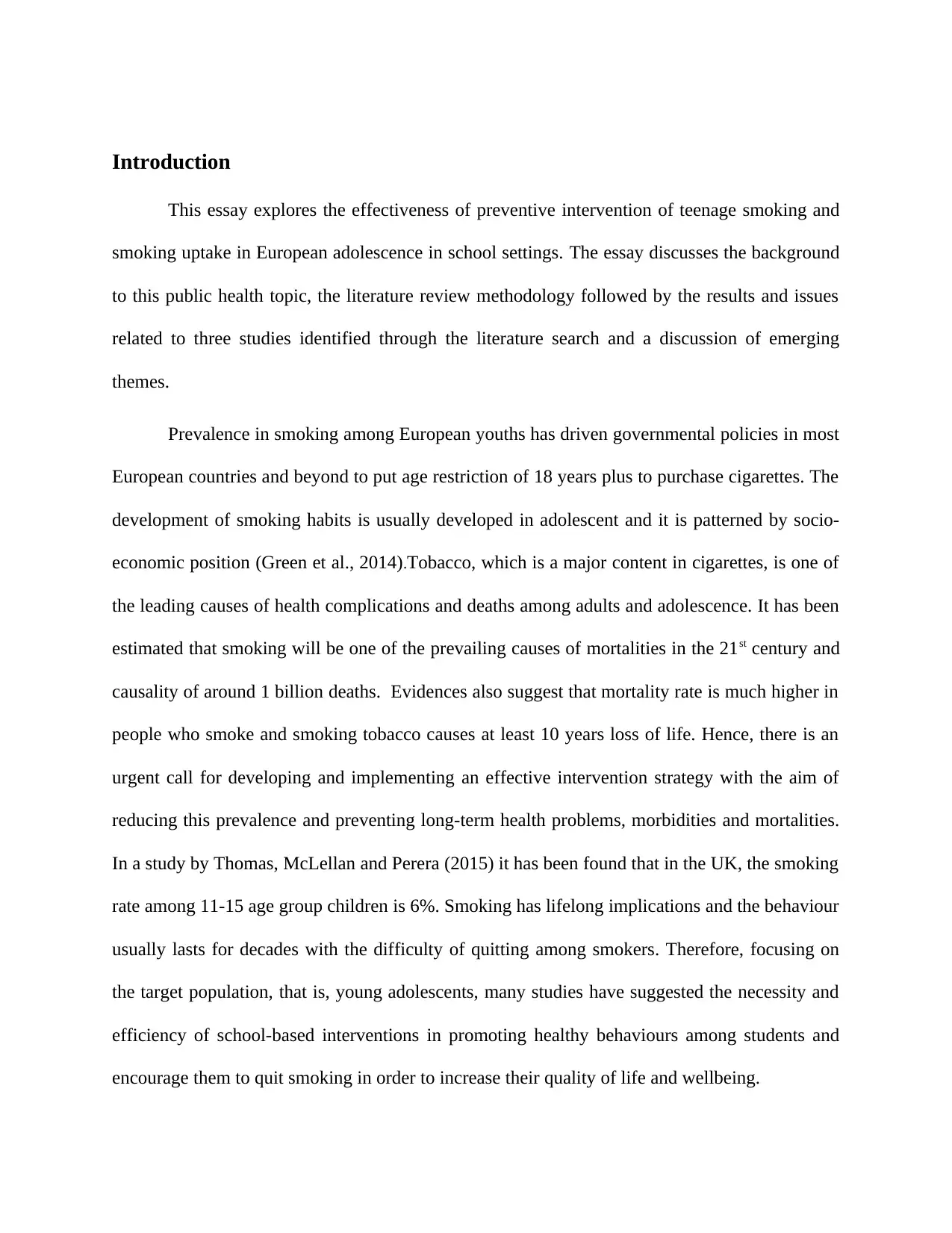
Introduction
This essay explores the effectiveness of preventive intervention of teenage smoking and
smoking uptake in European adolescence in school settings. The essay discusses the background
to this public health topic, the literature review methodology followed by the results and issues
related to three studies identified through the literature search and a discussion of emerging
themes.
Prevalence in smoking among European youths has driven governmental policies in most
European countries and beyond to put age restriction of 18 years plus to purchase cigarettes. The
development of smoking habits is usually developed in adolescent and it is patterned by socio-
economic position (Green et al., 2014).Tobacco, which is a major content in cigarettes, is one of
the leading causes of health complications and deaths among adults and adolescence. It has been
estimated that smoking will be one of the prevailing causes of mortalities in the 21st century and
causality of around 1 billion deaths. Evidences also suggest that mortality rate is much higher in
people who smoke and smoking tobacco causes at least 10 years loss of life. Hence, there is an
urgent call for developing and implementing an effective intervention strategy with the aim of
reducing this prevalence and preventing long-term health problems, morbidities and mortalities.
In a study by Thomas, McLellan and Perera (2015) it has been found that in the UK, the smoking
rate among 11-15 age group children is 6%. Smoking has lifelong implications and the behaviour
usually lasts for decades with the difficulty of quitting among smokers. Therefore, focusing on
the target population, that is, young adolescents, many studies have suggested the necessity and
efficiency of school-based interventions in promoting healthy behaviours among students and
encourage them to quit smoking in order to increase their quality of life and wellbeing.
This essay explores the effectiveness of preventive intervention of teenage smoking and
smoking uptake in European adolescence in school settings. The essay discusses the background
to this public health topic, the literature review methodology followed by the results and issues
related to three studies identified through the literature search and a discussion of emerging
themes.
Prevalence in smoking among European youths has driven governmental policies in most
European countries and beyond to put age restriction of 18 years plus to purchase cigarettes. The
development of smoking habits is usually developed in adolescent and it is patterned by socio-
economic position (Green et al., 2014).Tobacco, which is a major content in cigarettes, is one of
the leading causes of health complications and deaths among adults and adolescence. It has been
estimated that smoking will be one of the prevailing causes of mortalities in the 21st century and
causality of around 1 billion deaths. Evidences also suggest that mortality rate is much higher in
people who smoke and smoking tobacco causes at least 10 years loss of life. Hence, there is an
urgent call for developing and implementing an effective intervention strategy with the aim of
reducing this prevalence and preventing long-term health problems, morbidities and mortalities.
In a study by Thomas, McLellan and Perera (2015) it has been found that in the UK, the smoking
rate among 11-15 age group children is 6%. Smoking has lifelong implications and the behaviour
usually lasts for decades with the difficulty of quitting among smokers. Therefore, focusing on
the target population, that is, young adolescents, many studies have suggested the necessity and
efficiency of school-based interventions in promoting healthy behaviours among students and
encourage them to quit smoking in order to increase their quality of life and wellbeing.
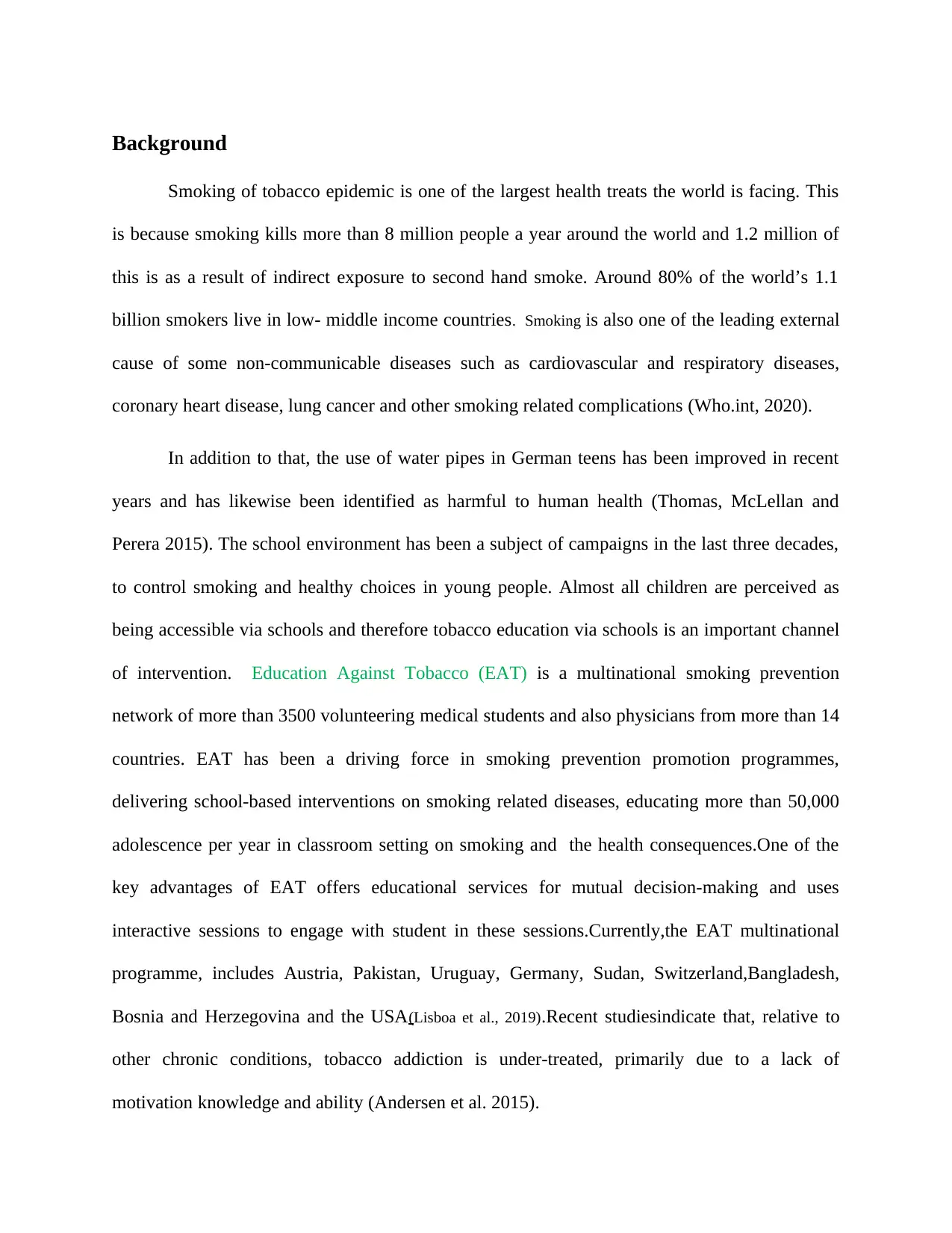
Background
Smoking of tobacco epidemic is one of the largest health treats the world is facing. This
is because smoking kills more than 8 million people a year around the world and 1.2 million of
this is as a result of indirect exposure to second hand smoke. Around 80% of the world’s 1.1
billion smokers live in low- middle income countries. Smoking is also one of the leading external
cause of some non-communicable diseases such as cardiovascular and respiratory diseases,
coronary heart disease, lung cancer and other smoking related complications (Who.int, 2020).
In addition to that, the use of water pipes in German teens has been improved in recent
years and has likewise been identified as harmful to human health (Thomas, McLellan and
Perera 2015). The school environment has been a subject of campaigns in the last three decades,
to control smoking and healthy choices in young people. Almost all children are perceived as
being accessible via schools and therefore tobacco education via schools is an important channel
of intervention. Education Against Tobacco (EAT) is a multinational smoking prevention
network of more than 3500 volunteering medical students and also physicians from more than 14
countries. EAT has been a driving force in smoking prevention promotion programmes,
delivering school-based interventions on smoking related diseases, educating more than 50,000
adolescence per year in classroom setting on smoking and the health consequences.One of the
key advantages of EAT offers educational services for mutual decision-making and uses
interactive sessions to engage with student in these sessions.Currently,the EAT multinational
programme, includes Austria, Pakistan, Uruguay, Germany, Sudan, Switzerland,Bangladesh,
Bosnia and Herzegovina and the USA(Lisboa et al., 2019).Recent studiesindicate that, relative to
other chronic conditions, tobacco addiction is under-treated, primarily due to a lack of
motivation knowledge and ability (Andersen et al. 2015).
Smoking of tobacco epidemic is one of the largest health treats the world is facing. This
is because smoking kills more than 8 million people a year around the world and 1.2 million of
this is as a result of indirect exposure to second hand smoke. Around 80% of the world’s 1.1
billion smokers live in low- middle income countries. Smoking is also one of the leading external
cause of some non-communicable diseases such as cardiovascular and respiratory diseases,
coronary heart disease, lung cancer and other smoking related complications (Who.int, 2020).
In addition to that, the use of water pipes in German teens has been improved in recent
years and has likewise been identified as harmful to human health (Thomas, McLellan and
Perera 2015). The school environment has been a subject of campaigns in the last three decades,
to control smoking and healthy choices in young people. Almost all children are perceived as
being accessible via schools and therefore tobacco education via schools is an important channel
of intervention. Education Against Tobacco (EAT) is a multinational smoking prevention
network of more than 3500 volunteering medical students and also physicians from more than 14
countries. EAT has been a driving force in smoking prevention promotion programmes,
delivering school-based interventions on smoking related diseases, educating more than 50,000
adolescence per year in classroom setting on smoking and the health consequences.One of the
key advantages of EAT offers educational services for mutual decision-making and uses
interactive sessions to engage with student in these sessions.Currently,the EAT multinational
programme, includes Austria, Pakistan, Uruguay, Germany, Sudan, Switzerland,Bangladesh,
Bosnia and Herzegovina and the USA(Lisboa et al., 2019).Recent studiesindicate that, relative to
other chronic conditions, tobacco addiction is under-treated, primarily due to a lack of
motivation knowledge and ability (Andersen et al. 2015).
⊘ This is a preview!⊘
Do you want full access?
Subscribe today to unlock all pages.

Trusted by 1+ million students worldwide
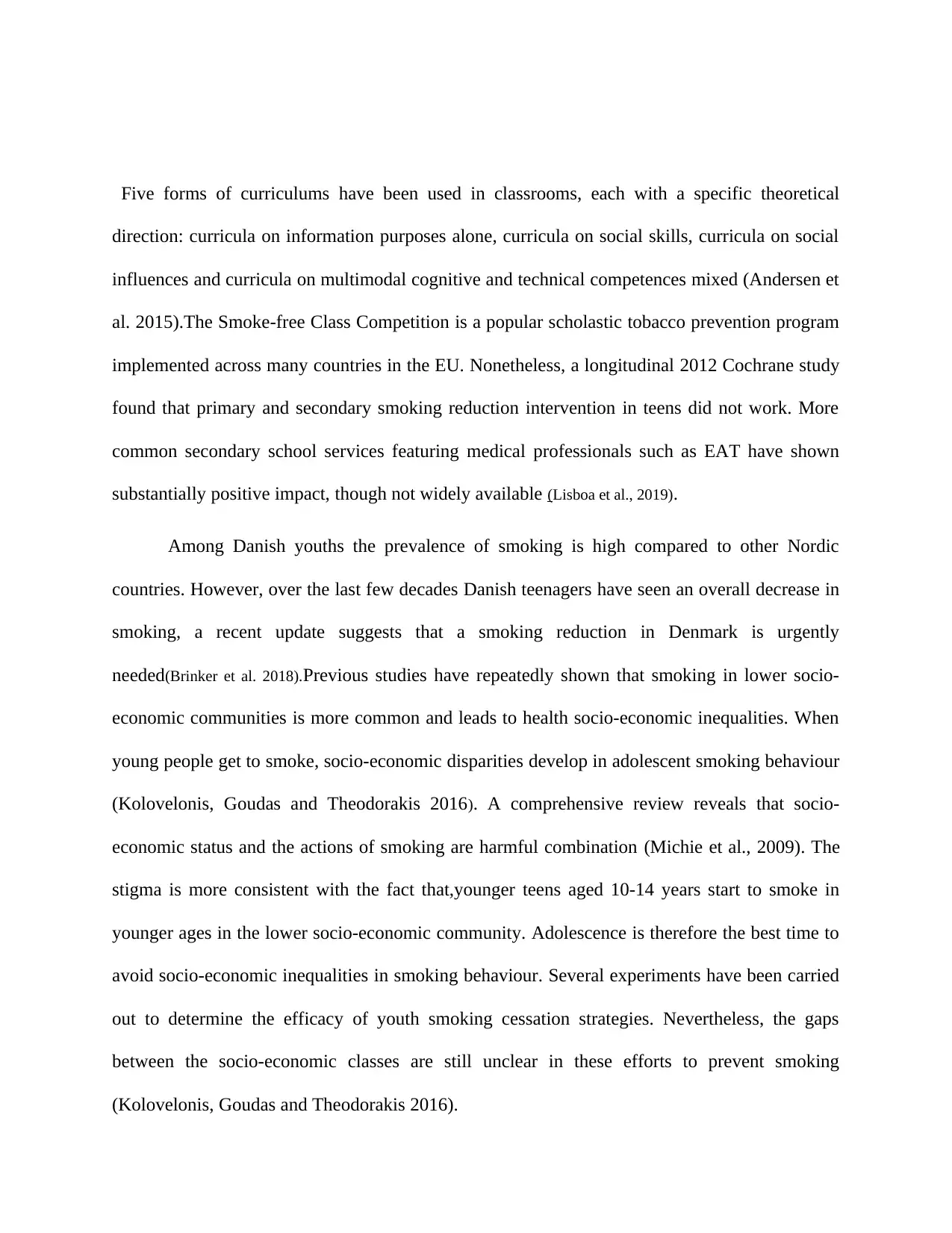
Five forms of curriculums have been used in classrooms, each with a specific theoretical
direction: curricula on information purposes alone, curricula on social skills, curricula on social
influences and curricula on multimodal cognitive and technical competences mixed (Andersen et
al. 2015).The Smoke-free Class Competition is a popular scholastic tobacco prevention program
implemented across many countries in the EU. Nonetheless, a longitudinal 2012 Cochrane study
found that primary and secondary smoking reduction intervention in teens did not work. More
common secondary school services featuring medical professionals such as EAT have shown
substantially positive impact, though not widely available (Lisboa et al., 2019).
Among Danish youths the prevalence of smoking is high compared to other Nordic
countries. However, over the last few decades Danish teenagers have seen an overall decrease in
smoking, a recent update suggests that a smoking reduction in Denmark is urgently
needed(Brinker et al. 2018).Previous studies have repeatedly shown that smoking in lower socio-
economic communities is more common and leads to health socio-economic inequalities. When
young people get to smoke, socio-economic disparities develop in adolescent smoking behaviour
(Kolovelonis, Goudas and Theodorakis 2016). A comprehensive review reveals that socio-
economic status and the actions of smoking are harmful combination (Michie et al., 2009). The
stigma is more consistent with the fact that,younger teens aged 10-14 years start to smoke in
younger ages in the lower socio-economic community. Adolescence is therefore the best time to
avoid socio-economic inequalities in smoking behaviour. Several experiments have been carried
out to determine the efficacy of youth smoking cessation strategies. Nevertheless, the gaps
between the socio-economic classes are still unclear in these efforts to prevent smoking
(Kolovelonis, Goudas and Theodorakis 2016).
direction: curricula on information purposes alone, curricula on social skills, curricula on social
influences and curricula on multimodal cognitive and technical competences mixed (Andersen et
al. 2015).The Smoke-free Class Competition is a popular scholastic tobacco prevention program
implemented across many countries in the EU. Nonetheless, a longitudinal 2012 Cochrane study
found that primary and secondary smoking reduction intervention in teens did not work. More
common secondary school services featuring medical professionals such as EAT have shown
substantially positive impact, though not widely available (Lisboa et al., 2019).
Among Danish youths the prevalence of smoking is high compared to other Nordic
countries. However, over the last few decades Danish teenagers have seen an overall decrease in
smoking, a recent update suggests that a smoking reduction in Denmark is urgently
needed(Brinker et al. 2018).Previous studies have repeatedly shown that smoking in lower socio-
economic communities is more common and leads to health socio-economic inequalities. When
young people get to smoke, socio-economic disparities develop in adolescent smoking behaviour
(Kolovelonis, Goudas and Theodorakis 2016). A comprehensive review reveals that socio-
economic status and the actions of smoking are harmful combination (Michie et al., 2009). The
stigma is more consistent with the fact that,younger teens aged 10-14 years start to smoke in
younger ages in the lower socio-economic community. Adolescence is therefore the best time to
avoid socio-economic inequalities in smoking behaviour. Several experiments have been carried
out to determine the efficacy of youth smoking cessation strategies. Nevertheless, the gaps
between the socio-economic classes are still unclear in these efforts to prevent smoking
(Kolovelonis, Goudas and Theodorakis 2016).
Paraphrase This Document
Need a fresh take? Get an instant paraphrase of this document with our AI Paraphraser
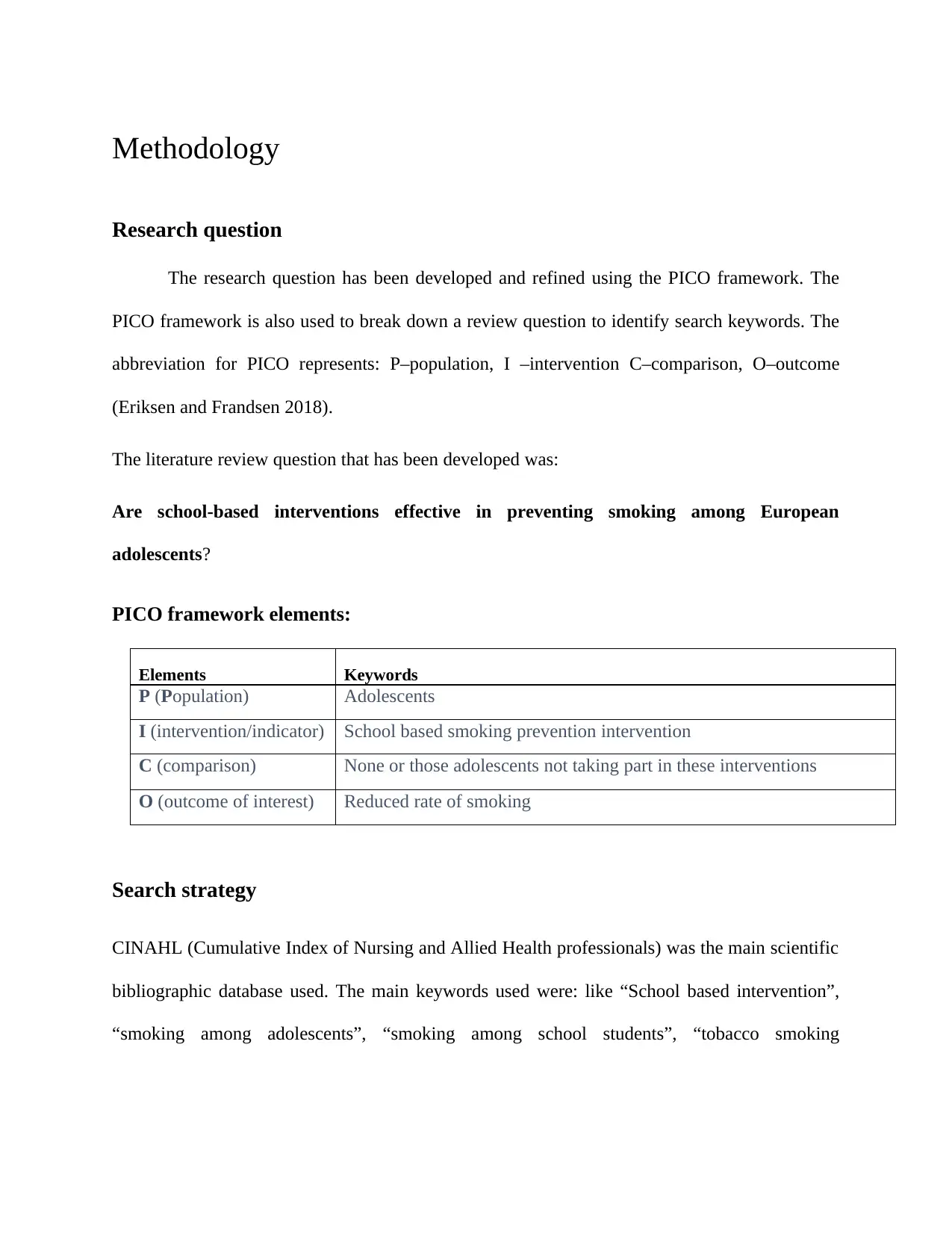
Methodology
Research question
The research question has been developed and refined using the PICO framework. The
PICO framework is also used to break down a review question to identify search keywords. The
abbreviation for PICO represents: P–population, I –intervention C–comparison, O–outcome
(Eriksen and Frandsen 2018).
The literature review question that has been developed was:
Are school-based interventions effective in preventing smoking among European
adolescents?
PICO framework elements:
Elements Keywords
P (Population) Adolescents
I (intervention/indicator) School based smoking prevention intervention
C (comparison) None or those adolescents not taking part in these interventions
O (outcome of interest) Reduced rate of smoking
Search strategy
CINAHL (Cumulative Index of Nursing and Allied Health professionals) was the main scientific
bibliographic database used. The main keywords used were: like “School based intervention”,
“smoking among adolescents”, “smoking among school students”, “tobacco smoking
Research question
The research question has been developed and refined using the PICO framework. The
PICO framework is also used to break down a review question to identify search keywords. The
abbreviation for PICO represents: P–population, I –intervention C–comparison, O–outcome
(Eriksen and Frandsen 2018).
The literature review question that has been developed was:
Are school-based interventions effective in preventing smoking among European
adolescents?
PICO framework elements:
Elements Keywords
P (Population) Adolescents
I (intervention/indicator) School based smoking prevention intervention
C (comparison) None or those adolescents not taking part in these interventions
O (outcome of interest) Reduced rate of smoking
Search strategy
CINAHL (Cumulative Index of Nursing and Allied Health professionals) was the main scientific
bibliographic database used. The main keywords used were: like “School based intervention”,
“smoking among adolescents”, “smoking among school students”, “tobacco smoking
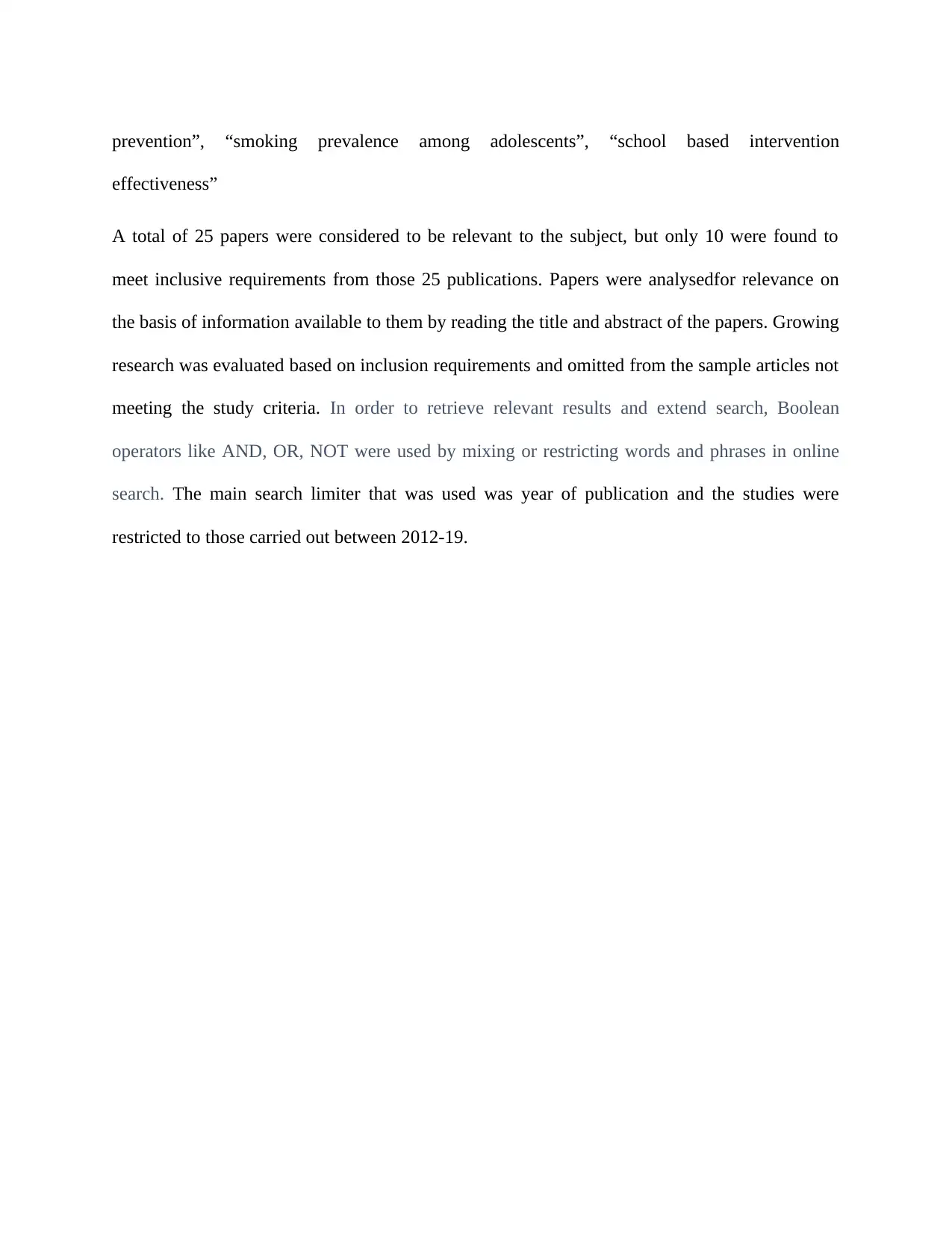
prevention”, “smoking prevalence among adolescents”, “school based intervention
effectiveness”
A total of 25 papers were considered to be relevant to the subject, but only 10 were found to
meet inclusive requirements from those 25 publications. Papers were analysedfor relevance on
the basis of information available to them by reading the title and abstract of the papers. Growing
research was evaluated based on inclusion requirements and omitted from the sample articles not
meeting the study criteria. In order to retrieve relevant results and extend search, Boolean
operators like AND, OR, NOT were used by mixing or restricting words and phrases in online
search. The main search limiter that was used was year of publication and the studies were
restricted to those carried out between 2012-19.
effectiveness”
A total of 25 papers were considered to be relevant to the subject, but only 10 were found to
meet inclusive requirements from those 25 publications. Papers were analysedfor relevance on
the basis of information available to them by reading the title and abstract of the papers. Growing
research was evaluated based on inclusion requirements and omitted from the sample articles not
meeting the study criteria. In order to retrieve relevant results and extend search, Boolean
operators like AND, OR, NOT were used by mixing or restricting words and phrases in online
search. The main search limiter that was used was year of publication and the studies were
restricted to those carried out between 2012-19.
⊘ This is a preview!⊘
Do you want full access?
Subscribe today to unlock all pages.

Trusted by 1+ million students worldwide
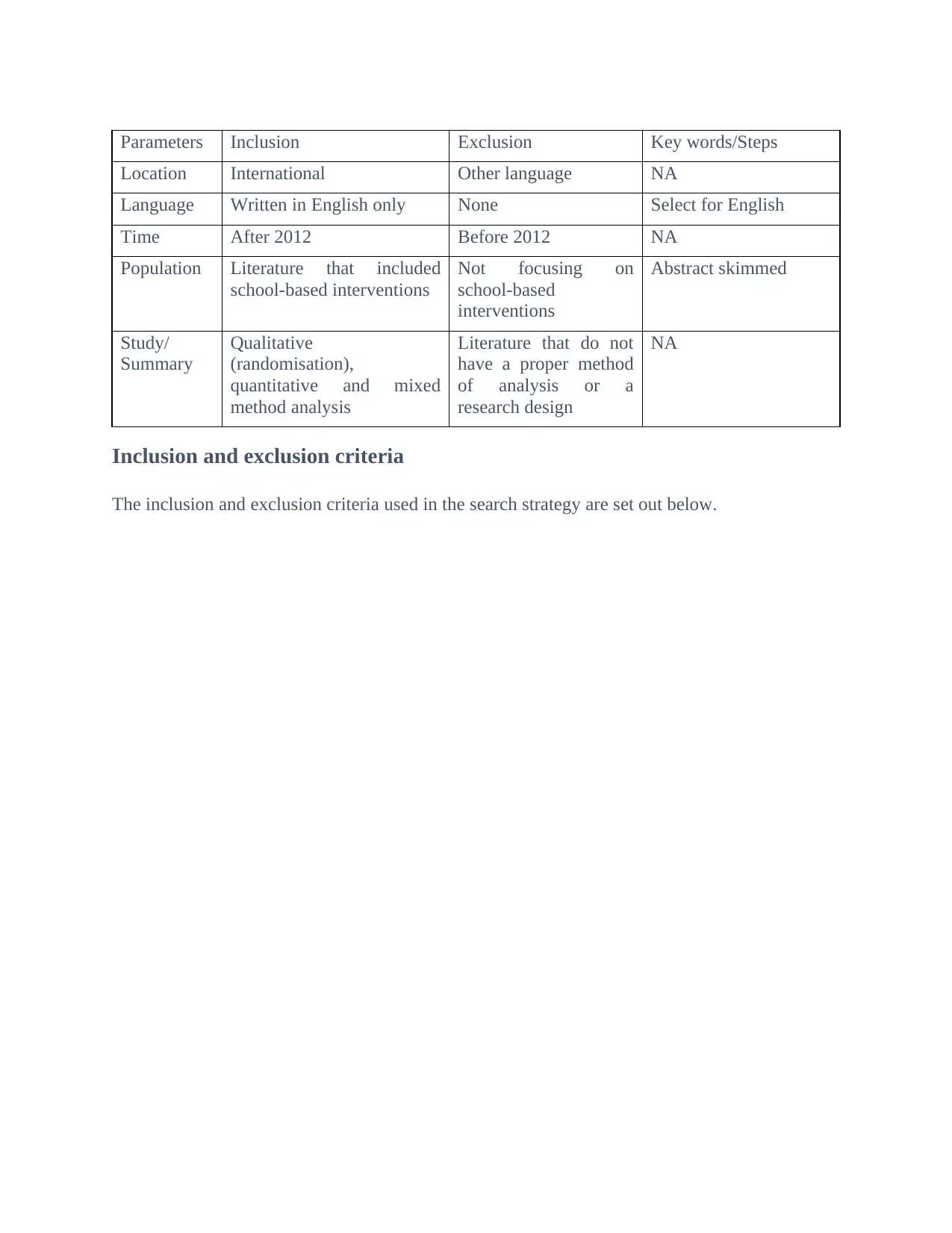
Parameters Inclusion Exclusion Key words/Steps
Location International Other language NA
Language Written in English only None Select for English
Time After 2012 Before 2012 NA
Population Literature that included
school-based interventions
Not focusing on
school-based
interventions
Abstract skimmed
Study/
Summary
Qualitative
(randomisation),
quantitative and mixed
method analysis
Literature that do not
have a proper method
of analysis or a
research design
NA
Inclusion and exclusion criteria
The inclusion and exclusion criteria used in the search strategy are set out below.
Location International Other language NA
Language Written in English only None Select for English
Time After 2012 Before 2012 NA
Population Literature that included
school-based interventions
Not focusing on
school-based
interventions
Abstract skimmed
Study/
Summary
Qualitative
(randomisation),
quantitative and mixed
method analysis
Literature that do not
have a proper method
of analysis or a
research design
NA
Inclusion and exclusion criteria
The inclusion and exclusion criteria used in the search strategy are set out below.
Paraphrase This Document
Need a fresh take? Get an instant paraphrase of this document with our AI Paraphraser
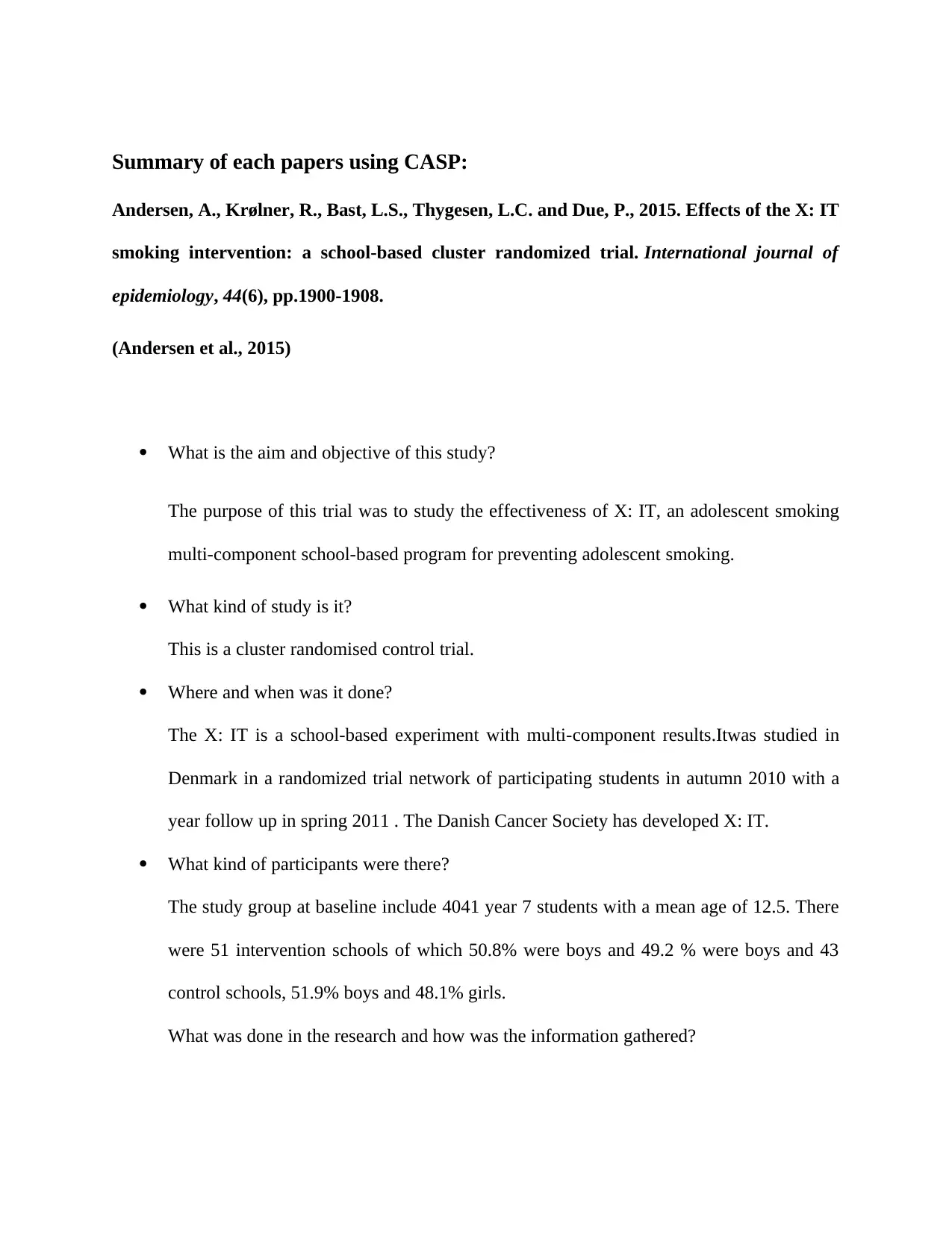
Summary of each papers using CASP:
Andersen, A., Krølner, R., Bast, L.S., Thygesen, L.C. and Due, P., 2015. Effects of the X: IT
smoking intervention: a school-based cluster randomized trial. International journal of
epidemiology, 44(6), pp.1900-1908.
(Andersen et al., 2015)
What is the aim and objective of this study?
The purpose of this trial was to study the effectiveness of X: IT, an adolescent smoking
multi-component school-based program for preventing adolescent smoking.
What kind of study is it?
This is a cluster randomised control trial.
Where and when was it done?
The X: IT is a school-based experiment with multi-component results.Itwas studied in
Denmark in a randomized trial network of participating students in autumn 2010 with a
year follow up in spring 2011 . The Danish Cancer Society has developed X: IT.
What kind of participants were there?
The study group at baseline include 4041 year 7 students with a mean age of 12.5. There
were 51 intervention schools of which 50.8% were boys and 49.2 % were boys and 43
control schools, 51.9% boys and 48.1% girls.
What was done in the research and how was the information gathered?
Andersen, A., Krølner, R., Bast, L.S., Thygesen, L.C. and Due, P., 2015. Effects of the X: IT
smoking intervention: a school-based cluster randomized trial. International journal of
epidemiology, 44(6), pp.1900-1908.
(Andersen et al., 2015)
What is the aim and objective of this study?
The purpose of this trial was to study the effectiveness of X: IT, an adolescent smoking
multi-component school-based program for preventing adolescent smoking.
What kind of study is it?
This is a cluster randomised control trial.
Where and when was it done?
The X: IT is a school-based experiment with multi-component results.Itwas studied in
Denmark in a randomized trial network of participating students in autumn 2010 with a
year follow up in spring 2011 . The Danish Cancer Society has developed X: IT.
What kind of participants were there?
The study group at baseline include 4041 year 7 students with a mean age of 12.5. There
were 51 intervention schools of which 50.8% were boys and 49.2 % were boys and 43
control schools, 51.9% boys and 48.1% girls.
What was done in the research and how was the information gathered?
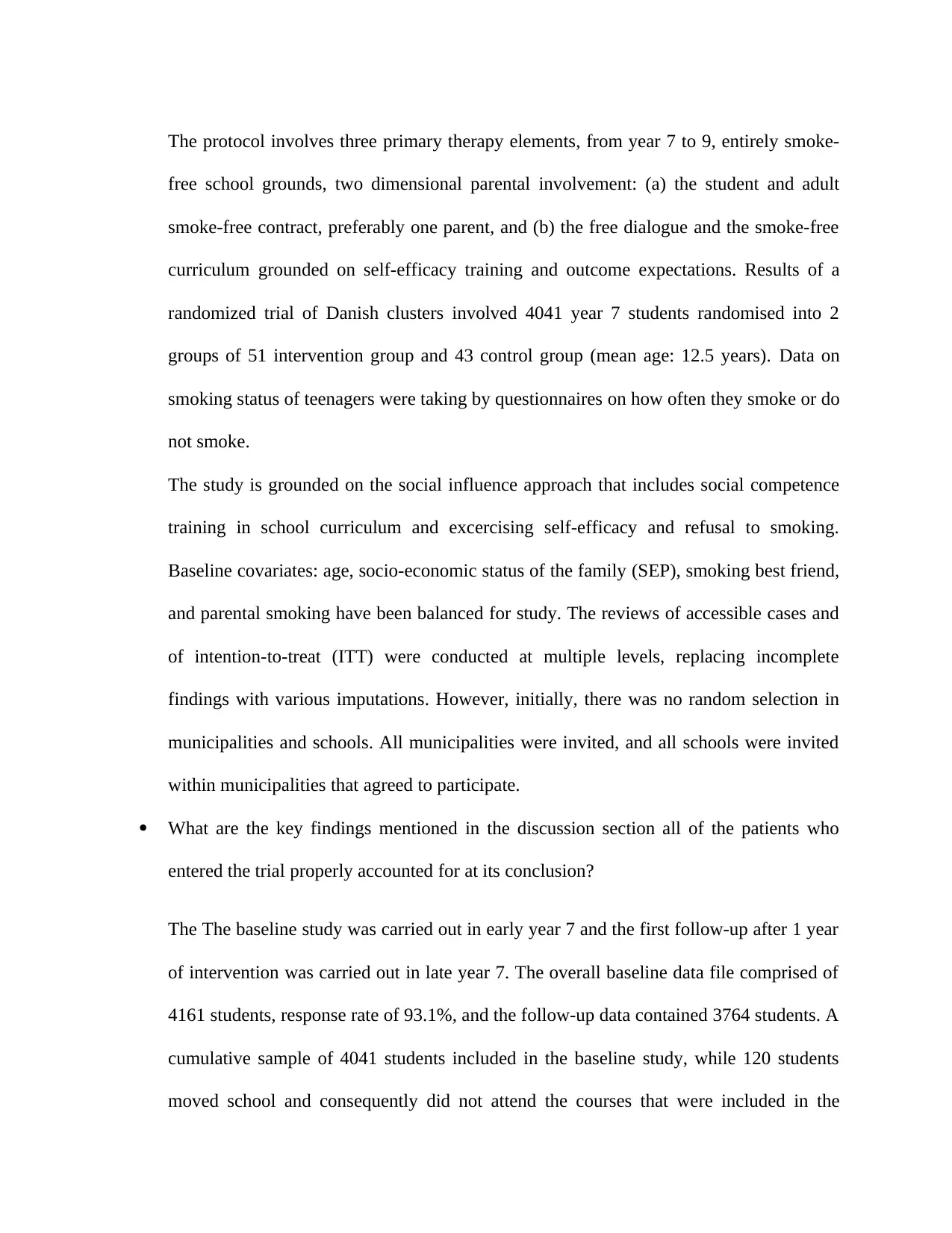
The protocol involves three primary therapy elements, from year 7 to 9, entirely smoke-
free school grounds, two dimensional parental involvement: (a) the student and adult
smoke-free contract, preferably one parent, and (b) the free dialogue and the smoke-free
curriculum grounded on self-efficacy training and outcome expectations. Results of a
randomized trial of Danish clusters involved 4041 year 7 students randomised into 2
groups of 51 intervention group and 43 control group (mean age: 12.5 years). Data on
smoking status of teenagers were taking by questionnaires on how often they smoke or do
not smoke.
The study is grounded on the social influence approach that includes social competence
training in school curriculum and excercising self-efficacy and refusal to smoking.
Baseline covariates: age, socio-economic status of the family (SEP), smoking best friend,
and parental smoking have been balanced for study. The reviews of accessible cases and
of intention-to-treat (ITT) were conducted at multiple levels, replacing incomplete
findings with various imputations. However, initially, there was no random selection in
municipalities and schools. All municipalities were invited, and all schools were invited
within municipalities that agreed to participate.
What are the key findings mentioned in the discussion section all of the patients who
entered the trial properly accounted for at its conclusion?
The The baseline study was carried out in early year 7 and the first follow-up after 1 year
of intervention was carried out in late year 7. The overall baseline data file comprised of
4161 students, response rate of 93.1%, and the follow-up data contained 3764 students. A
cumulative sample of 4041 students included in the baseline study, while 120 students
moved school and consequently did not attend the courses that were included in the
free school grounds, two dimensional parental involvement: (a) the student and adult
smoke-free contract, preferably one parent, and (b) the free dialogue and the smoke-free
curriculum grounded on self-efficacy training and outcome expectations. Results of a
randomized trial of Danish clusters involved 4041 year 7 students randomised into 2
groups of 51 intervention group and 43 control group (mean age: 12.5 years). Data on
smoking status of teenagers were taking by questionnaires on how often they smoke or do
not smoke.
The study is grounded on the social influence approach that includes social competence
training in school curriculum and excercising self-efficacy and refusal to smoking.
Baseline covariates: age, socio-economic status of the family (SEP), smoking best friend,
and parental smoking have been balanced for study. The reviews of accessible cases and
of intention-to-treat (ITT) were conducted at multiple levels, replacing incomplete
findings with various imputations. However, initially, there was no random selection in
municipalities and schools. All municipalities were invited, and all schools were invited
within municipalities that agreed to participate.
What are the key findings mentioned in the discussion section all of the patients who
entered the trial properly accounted for at its conclusion?
The The baseline study was carried out in early year 7 and the first follow-up after 1 year
of intervention was carried out in late year 7. The overall baseline data file comprised of
4161 students, response rate of 93.1%, and the follow-up data contained 3764 students. A
cumulative sample of 4041 students included in the baseline study, while 120 students
moved school and consequently did not attend the courses that were included in the
⊘ This is a preview!⊘
Do you want full access?
Subscribe today to unlock all pages.

Trusted by 1+ million students worldwide
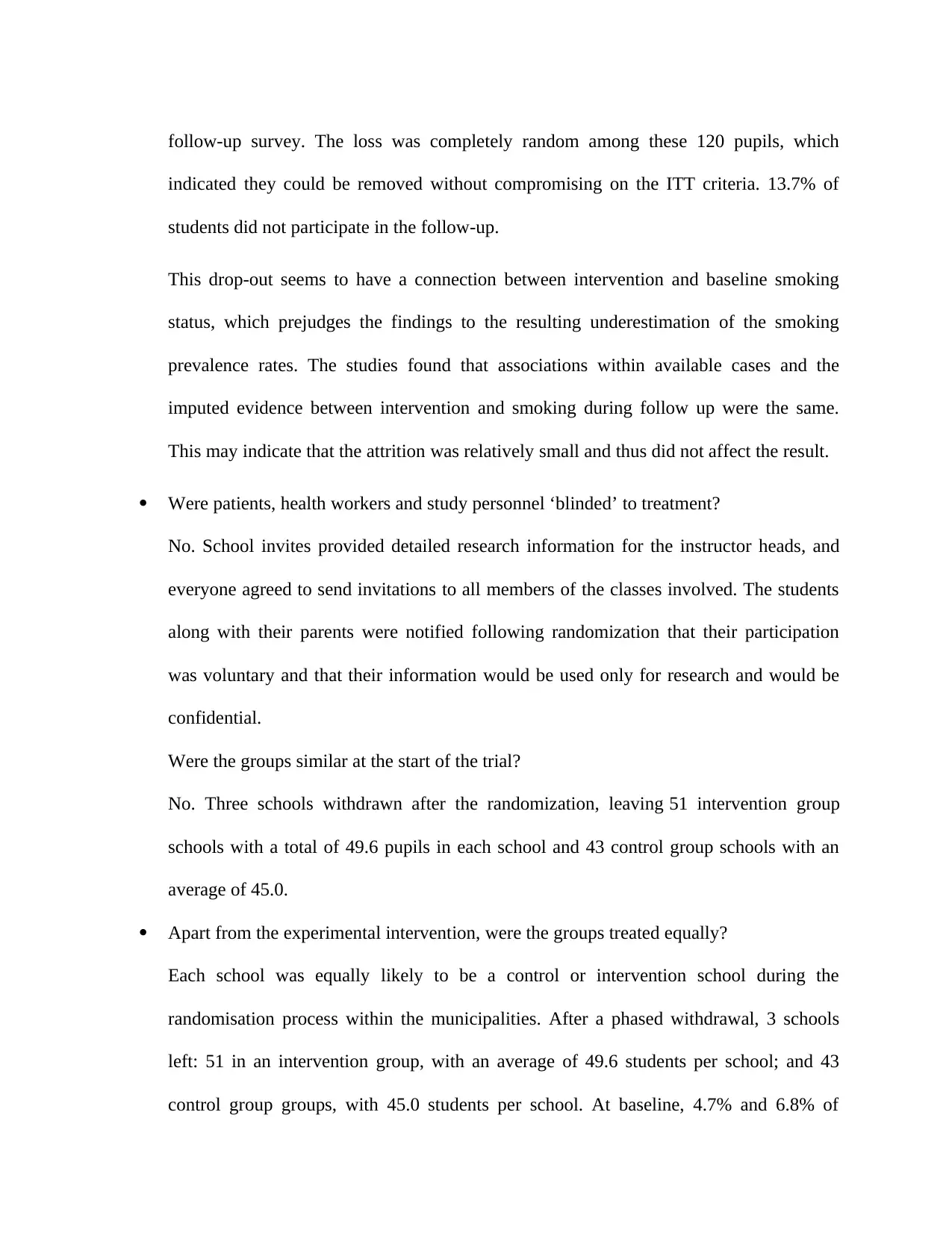
follow-up survey. The loss was completely random among these 120 pupils, which
indicated they could be removed without compromising on the ITT criteria. 13.7% of
students did not participate in the follow-up.
This drop-out seems to have a connection between intervention and baseline smoking
status, which prejudges the findings to the resulting underestimation of the smoking
prevalence rates. The studies found that associations within available cases and the
imputed evidence between intervention and smoking during follow up were the same.
This may indicate that the attrition was relatively small and thus did not affect the result.
Were patients, health workers and study personnel ‘blinded’ to treatment?
No. School invites provided detailed research information for the instructor heads, and
everyone agreed to send invitations to all members of the classes involved. The students
along with their parents were notified following randomization that their participation
was voluntary and that their information would be used only for research and would be
confidential.
Were the groups similar at the start of the trial?
No. Three schools withdrawn after the randomization, leaving 51 intervention group
schools with a total of 49.6 pupils in each school and 43 control group schools with an
average of 45.0.
Apart from the experimental intervention, were the groups treated equally?
Each school was equally likely to be a control or intervention school during the
randomisation process within the municipalities. After a phased withdrawal, 3 schools
left: 51 in an intervention group, with an average of 49.6 students per school; and 43
control group groups, with 45.0 students per school. At baseline, 4.7% and 6.8% of
indicated they could be removed without compromising on the ITT criteria. 13.7% of
students did not participate in the follow-up.
This drop-out seems to have a connection between intervention and baseline smoking
status, which prejudges the findings to the resulting underestimation of the smoking
prevalence rates. The studies found that associations within available cases and the
imputed evidence between intervention and smoking during follow up were the same.
This may indicate that the attrition was relatively small and thus did not affect the result.
Were patients, health workers and study personnel ‘blinded’ to treatment?
No. School invites provided detailed research information for the instructor heads, and
everyone agreed to send invitations to all members of the classes involved. The students
along with their parents were notified following randomization that their participation
was voluntary and that their information would be used only for research and would be
confidential.
Were the groups similar at the start of the trial?
No. Three schools withdrawn after the randomization, leaving 51 intervention group
schools with a total of 49.6 pupils in each school and 43 control group schools with an
average of 45.0.
Apart from the experimental intervention, were the groups treated equally?
Each school was equally likely to be a control or intervention school during the
randomisation process within the municipalities. After a phased withdrawal, 3 schools
left: 51 in an intervention group, with an average of 49.6 students per school; and 43
control group groups, with 45.0 students per school. At baseline, 4.7% and 6.8% of
Paraphrase This Document
Need a fresh take? Get an instant paraphrase of this document with our AI Paraphraser
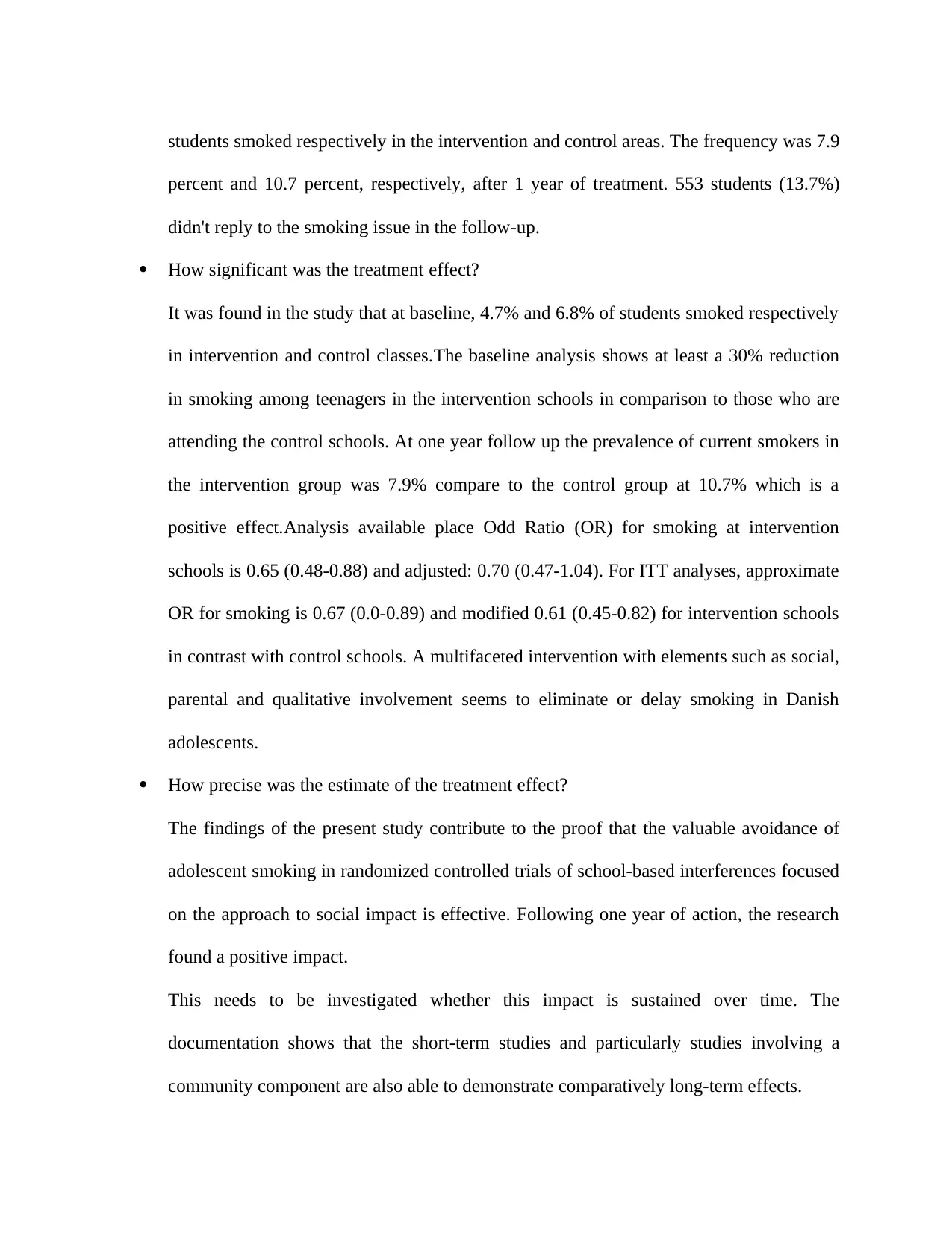
students smoked respectively in the intervention and control areas. The frequency was 7.9
percent and 10.7 percent, respectively, after 1 year of treatment. 553 students (13.7%)
didn't reply to the smoking issue in the follow-up.
How significant was the treatment effect?
It was found in the study that at baseline, 4.7% and 6.8% of students smoked respectively
in intervention and control classes.The baseline analysis shows at least a 30% reduction
in smoking among teenagers in the intervention schools in comparison to those who are
attending the control schools. At one year follow up the prevalence of current smokers in
the intervention group was 7.9% compare to the control group at 10.7% which is a
positive effect.Analysis available place Odd Ratio (OR) for smoking at intervention
schools is 0.65 (0.48-0.88) and adjusted: 0.70 (0.47-1.04). For ITT analyses, approximate
OR for smoking is 0.67 (0.0-0.89) and modified 0.61 (0.45-0.82) for intervention schools
in contrast with control schools. A multifaceted intervention with elements such as social,
parental and qualitative involvement seems to eliminate or delay smoking in Danish
adolescents.
How precise was the estimate of the treatment effect?
The findings of the present study contribute to the proof that the valuable avoidance of
adolescent smoking in randomized controlled trials of school-based interferences focused
on the approach to social impact is effective. Following one year of action, the research
found a positive impact.
This needs to be investigated whether this impact is sustained over time. The
documentation shows that the short-term studies and particularly studies involving a
community component are also able to demonstrate comparatively long-term effects.
percent and 10.7 percent, respectively, after 1 year of treatment. 553 students (13.7%)
didn't reply to the smoking issue in the follow-up.
How significant was the treatment effect?
It was found in the study that at baseline, 4.7% and 6.8% of students smoked respectively
in intervention and control classes.The baseline analysis shows at least a 30% reduction
in smoking among teenagers in the intervention schools in comparison to those who are
attending the control schools. At one year follow up the prevalence of current smokers in
the intervention group was 7.9% compare to the control group at 10.7% which is a
positive effect.Analysis available place Odd Ratio (OR) for smoking at intervention
schools is 0.65 (0.48-0.88) and adjusted: 0.70 (0.47-1.04). For ITT analyses, approximate
OR for smoking is 0.67 (0.0-0.89) and modified 0.61 (0.45-0.82) for intervention schools
in contrast with control schools. A multifaceted intervention with elements such as social,
parental and qualitative involvement seems to eliminate or delay smoking in Danish
adolescents.
How precise was the estimate of the treatment effect?
The findings of the present study contribute to the proof that the valuable avoidance of
adolescent smoking in randomized controlled trials of school-based interferences focused
on the approach to social impact is effective. Following one year of action, the research
found a positive impact.
This needs to be investigated whether this impact is sustained over time. The
documentation shows that the short-term studies and particularly studies involving a
community component are also able to demonstrate comparatively long-term effects.
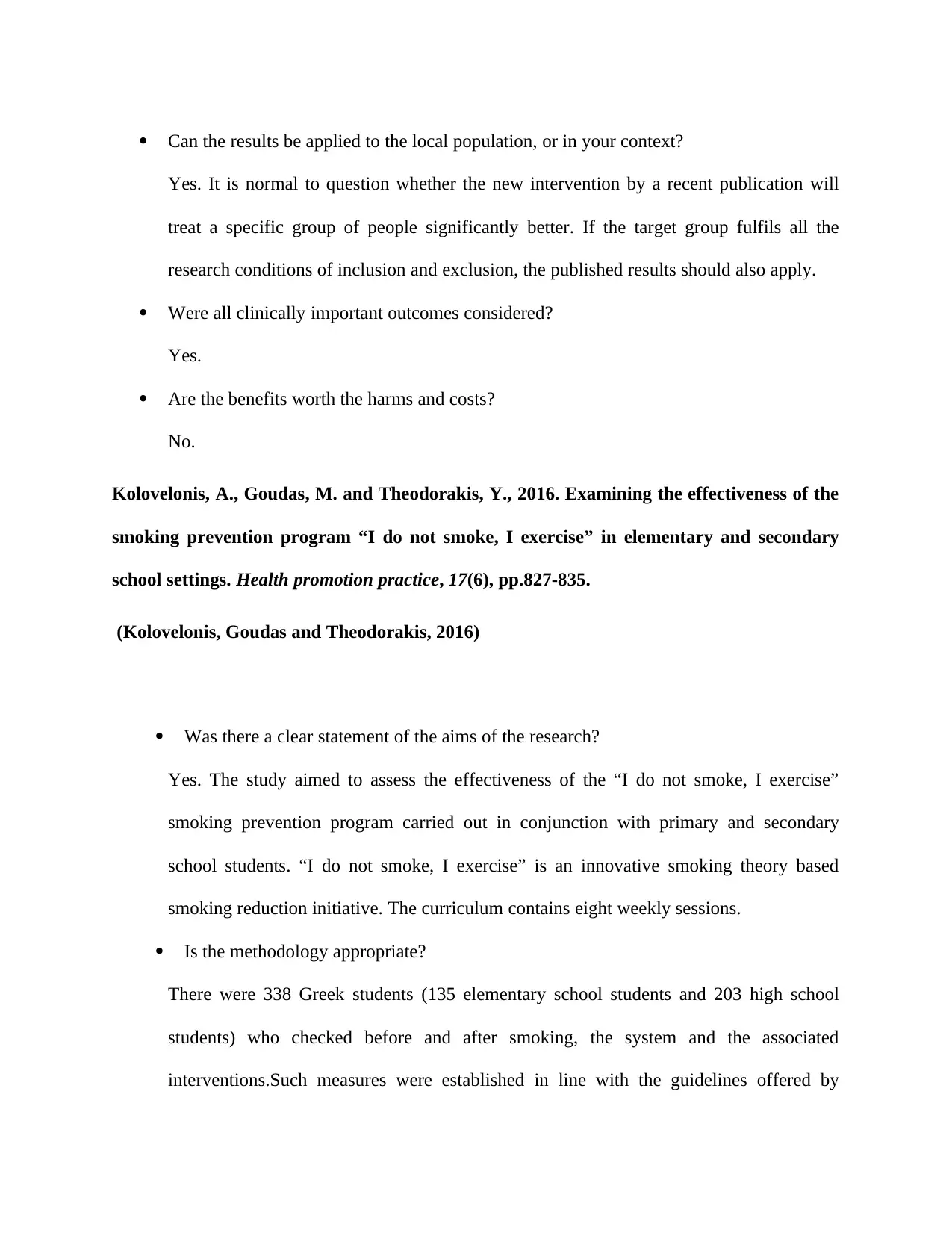
Can the results be applied to the local population, or in your context?
Yes. It is normal to question whether the new intervention by a recent publication will
treat a specific group of people significantly better. If the target group fulfils all the
research conditions of inclusion and exclusion, the published results should also apply.
Were all clinically important outcomes considered?
Yes.
Are the benefits worth the harms and costs?
No.
Kolovelonis, A., Goudas, M. and Theodorakis, Y., 2016. Examining the effectiveness of the
smoking prevention program “I do not smoke, I exercise” in elementary and secondary
school settings. Health promotion practice, 17(6), pp.827-835.
(Kolovelonis, Goudas and Theodorakis, 2016)
Was there a clear statement of the aims of the research?
Yes. The study aimed to assess the effectiveness of the “I do not smoke, I exercise”
smoking prevention program carried out in conjunction with primary and secondary
school students. “I do not smoke, I exercise” is an innovative smoking theory based
smoking reduction initiative. The curriculum contains eight weekly sessions.
Is the methodology appropriate?
There were 338 Greek students (135 elementary school students and 203 high school
students) who checked before and after smoking, the system and the associated
interventions.Such measures were established in line with the guidelines offered by
Yes. It is normal to question whether the new intervention by a recent publication will
treat a specific group of people significantly better. If the target group fulfils all the
research conditions of inclusion and exclusion, the published results should also apply.
Were all clinically important outcomes considered?
Yes.
Are the benefits worth the harms and costs?
No.
Kolovelonis, A., Goudas, M. and Theodorakis, Y., 2016. Examining the effectiveness of the
smoking prevention program “I do not smoke, I exercise” in elementary and secondary
school settings. Health promotion practice, 17(6), pp.827-835.
(Kolovelonis, Goudas and Theodorakis, 2016)
Was there a clear statement of the aims of the research?
Yes. The study aimed to assess the effectiveness of the “I do not smoke, I exercise”
smoking prevention program carried out in conjunction with primary and secondary
school students. “I do not smoke, I exercise” is an innovative smoking theory based
smoking reduction initiative. The curriculum contains eight weekly sessions.
Is the methodology appropriate?
There were 338 Greek students (135 elementary school students and 203 high school
students) who checked before and after smoking, the system and the associated
interventions.Such measures were established in line with the guidelines offered by
⊘ This is a preview!⊘
Do you want full access?
Subscribe today to unlock all pages.

Trusted by 1+ million students worldwide
1 out of 28
Related Documents
Your All-in-One AI-Powered Toolkit for Academic Success.
+13062052269
info@desklib.com
Available 24*7 on WhatsApp / Email
![[object Object]](/_next/static/media/star-bottom.7253800d.svg)
Unlock your academic potential
Copyright © 2020–2025 A2Z Services. All Rights Reserved. Developed and managed by ZUCOL.





